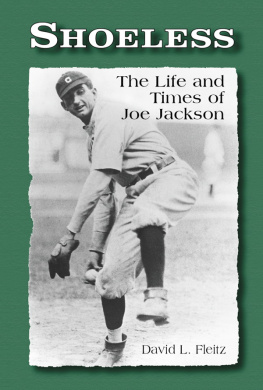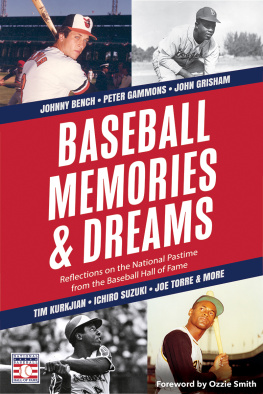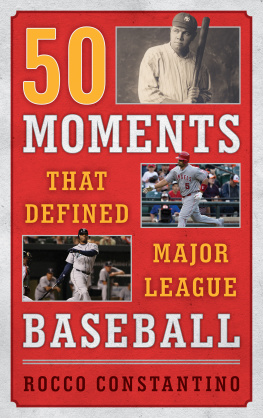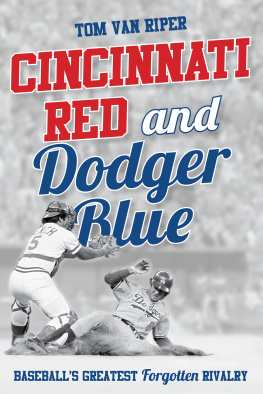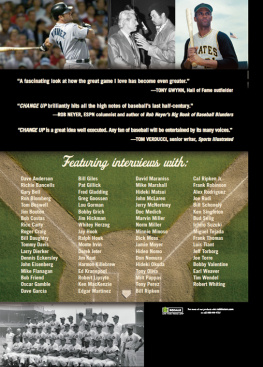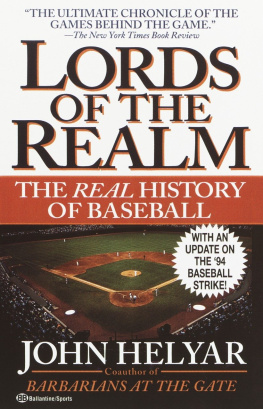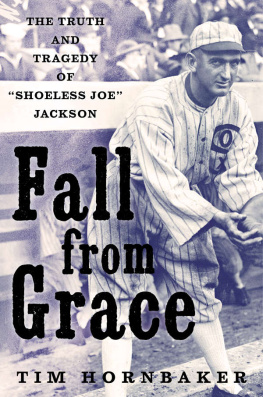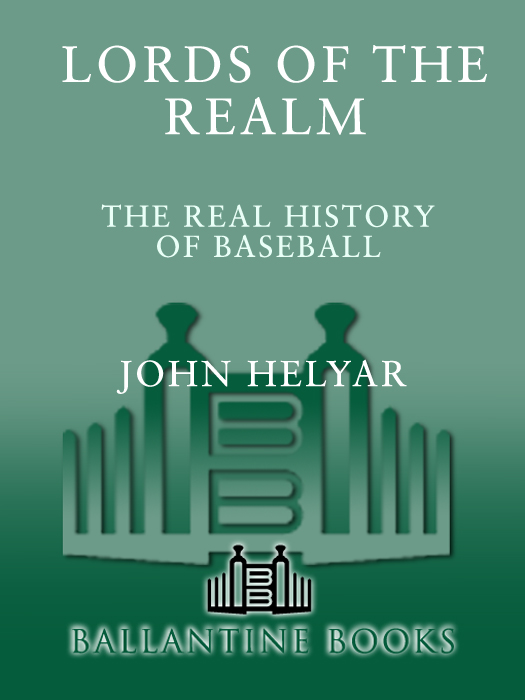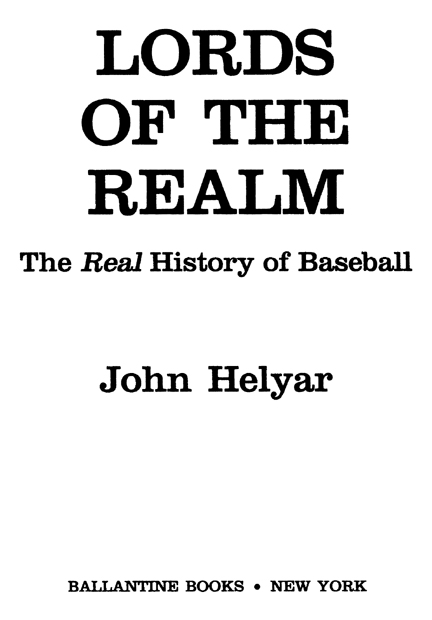ENLIGHTENING AND
PROVOCATIVE.
Publishers Weekly
A MUST-READ FOR BASEBALL FANS and for anyone who would like to know how the very wealthy and the very ambitious manage the business of Americas national pastime Helyar takes us inside the most intimate meetings at some of the most crucial moments in baseball history.
Kirkus Reviews
A LUCID, COMPELLING ECONOMIC HISTORY OF THE GAME A labyrinthine tale fueled by money and driven by a zany cast of characters that only baseball seems able to produce Helyar not only covers a lot of ground, but, more important, he places all of the events and people into a coherent context.
Booklist
ONE OF THE MOST ENTERTAINING SPORTS BOOKS OF THE YEAR. [Helyar] deftly weaves the financial facts with in-depth and entrancing profiles of many major league owners. [His] investigative skills make the book informative, while his sincere interest in the sport allows even the casual fan to read this work with great enjoyment. Captivating and insightful Highly recommended.
Library Journal
Also by John Helyar:
BARBARIANS AT THE GATE (with Bryan Burrough)
Copyright 1994 by John Helyar
All rights reserved under International and Pan-American Copyright Conventions. Published in the United States by Ballantine Books, a division of Random House, Inc., New York, and simultaneously in Canada by Random House of Canada Limited, Toronto.
Library of Congress Catalog Card Number: 93-41944
eISBN: 978-0-307-80142-5
This edition published by arrangement with Villard Books, a division of Random House, Inc. Villard Books is a registered trademark of Random House, Inc.
v3.1_r1
To Betsy and Johnny
and in memory of Daisie Helyar
The magnate must be a strong man among strong men, else other club owners in the league will combine in their own interests against him and his interest, and by collusion force him out of the game.
A. G. S PALDING ,
Chicago National League owner, 1890
The great trouble with baseball today is that most of the players are in the game for the money thats in itnot for the love of it, the excitement of it, the thrill of it.
T Y C OBB , 1925
Baseball was made for kids, and grown-ups only screw it up.
B OB F ELLER , pitcher
You go through The Sporting News for the last one hundred years, and you will find two things are always true. You never have enough pitching, and nobody ever made money.
D ONALD F EHR , executive director,
Major League Baseball Players Association
Gentlemen, we have the only legal monopoly in the country and were fucking it up.
T ED T URNER , owner, Atlanta Braves
Contents
Acknowledgments
This book has its origins on a summer night in 1960, when my father took me to my first baseball game. It was at Fenway Park; Ted Williams got a double; I was hooked.
Baseball has since given me some of lifes best moments (the Impossible Dream Red Sox of 1967) and its worst (the impossible agony of the ball going through Buckners legs). As a college student, I minored in baseball, in the Fenway bleachers. As an adult, Ive spent a glorious week at Grapefruit League exhibition games with the same set of friends every year since 1981.
As an adult, too, I sometimes wondered whether there was some strange law of compensation at work in baseball. Why was the grace of the game between the lines so precisely matched by the gracelessness of its off-field conduct?
The Wall Street Journal gave me the opportunity to find out. Norman Pearlstine lured me back to the newspaper in 1990 by offering me a beat covering the business of sports. I did several stories on baseball, and one in particular led to this book. I looked into what really happened during a three-year period when the owners froze the free-agent market.
What I found was less a price-fixing conspiracy than a fascinating group-dynamics study. It was a reaction to years of wrenching change in baseball and an effort by the owners to seize back control from the players. I found I couldnt examine the collusion era of 19851988 without understanding the events of the previous two decades. That was what provided the genesis of this book, a study of this quintessential American institution in transition.
I appreciate the support of Barney Calarne, my boss, and Paul Steiger, the Journals managing editor and leading baseball savant. They allowed me to expend considerable time and column inches to tell a very old story, by daily-newspaper standards. My thanks as well to Norm Pearlstine, who hardly oversold the possibilities of the sports beat.
I give my agent, Andrew Wylie, a world of credit for being the first to see the possibilities of a baseball book, and his colleague Deborah Karl a large measure of gratitude for aid and comfort along the way. At Villard Books, my thanks go to Diane Reverand, who brought this book into the world, and Peter Gethers, whose belief in the project and baseball knowledge sustained and improved it.
This book is primarily based on interviews with more than two hundred people in the baseball business, many of whom I interviewed multiple times. Space permits me to acknowledge just a fraction of them, but my thanks go to all for sharing their memories and insights and especially to the following:
Buzzie Bavasi, Peter Bavasi, Bob Boone, Charles Bronfman, Jim Bronner, Bryan Burns, Ruly Carpenter, Bob Costello, Doug DeCinces, Don Fehr, Steve Fehr, Ed Fitzgerald, John Gaherin, Phil Garner, Bill Giles, Bob Gilhooley, Ray Grebey, Clark Griffith, Sandy Hadden, Randy Hendricks, Lou Hoynes, Bob Howsam, Larry Lucchino, Andy MacPhail, Lee MacPhail, Tim McCarver, Joe McIlvaine, John McMullen, Andy Messersmith, Ken Moffett, Dick Moss, Chuck OConnor, Gene Orza, Dick Ravitch, Tom and Sam Reich, Jerry Reinsdorf, Lauren Rich, Robin Roberts, Barry Rona, Ken Schanzer, Bud Selig, Ted Simmons, Tal Smith, Jeff Smulyan, Joe Torre, Tom Villante, Dick Wagner, and Bill White.
In addition, Rich Levin and Jim Small of the commissioners office kept extending me credentials and other courtesies despite my persistent failure to give them adequate notice.
A number of books were also essential resources for me, topped by Marvin Millers A Whole Different Ballgame and Bowie Kuhns Hardball. Despite their sharp difference and taken as complementary perspectives, they were useful primers on the baseball business. I am grateful to Marvin Miller in particular for elaborating at length on certain events, despite having only recently covered the territory in his memoirs.
I drew on the treasure trove of Dodgers literature to assist in my portrayals of Walter OMalley, Branch Rickey, and Larry MacPhail. Of most note were Bums by Peter Golenbock; The Lords of Baseball by Harold Parrott; Rickey & Robinson by Harvey Frommer; The Roaring Redhead by Don Warfield; The Dodgers Move West by Neil J. Sullivan; and The Boys of Summer by Roger Kahn.
Some fine biographies aided other parts of the book, including The Man to See (Edward Bennett Williams) by Evan Thomas; Collision at Home Plate (Bart Giamatti) by James Reston, Jr.; and Under the Influence (Gussie Busch) by Peter Hernon and Terry Ganey. Three books were helpful in portraying the early Ted Turner:


